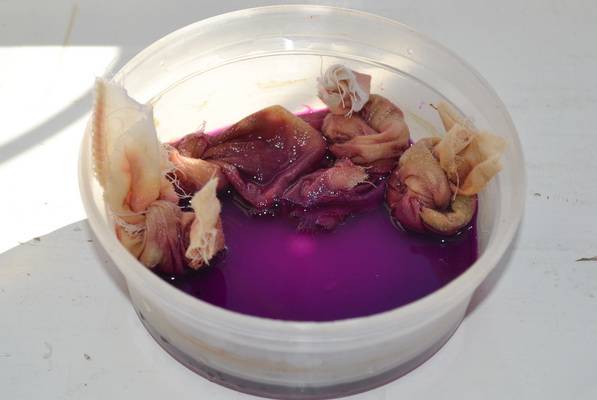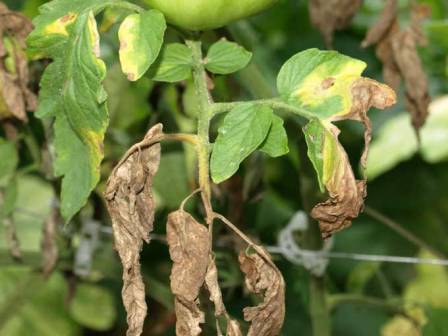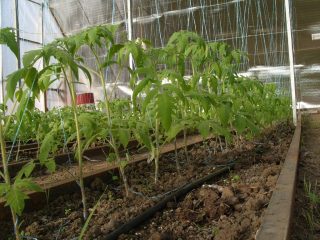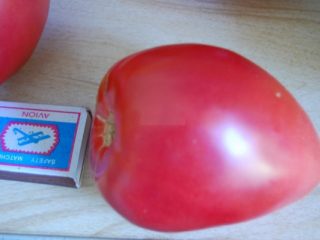Content
When growing tomatoes, people often wonder what preparations to treat the plants with. Vegetable growers who have extensive experience working with tomatoes often use products purchased at the pharmacy: iodine, brilliant green and potassium permanganate. Beginners have many questions regarding the use of pharmaceutical preparations, including potassium permanganate, for processing tomatoes. Firstly, what is potassium permanganate for plants - a fertilizer or an antiseptic. Secondly, in what doses it should be used. Thirdly, at what stage of vegetative development tomato processing potassium permanganate solution is most effective.
We will try to talk about the rules for using potassium permanganate (potassium permanganate) and the role of the substance for plants.
What is potassium permanganate
First, let's find out what this drug is. Potassium permanganate is an antiseptic. Oxidizing in air, it has an effective effect in destroying pathogenic bacteria and causative agents of certain infectious diseases.
In fact, the substance contains two microelements necessary for the proper development of plants: potassium and manganese. Manganese and wood ash contain small amounts of manganese.These microelements are also present in the soil, but plants cannot obtain them. The combination of two microelements increases the usefulness of potassium permanganate for the development of tomatoes.
For example, a lack of manganese can lead to interveinal chlorosis of leaves on tomatoes. Look at the photo below to see what diseased leaves look like.
Tomatoes, processed potassium permanganate, do not harm humans. They can be eaten without fear.
The importance of potassium permanganate for tomatoes
Gardeners have long used potassium permanganate when growing cultivated plants, including tomatoes, on their plots. The product is inexpensive, but is highly effective in combating some tomato diseases.
Let's find out why treating plants with potassium permanganate is useful:
- Firstly, since potassium permanganate is an antiseptic, the treatment allows you to reduce the number of microorganisms on the leaves and in the soil that inhibit the development of the plant. We cannot remain silent about the shortcomings. As a rule, beneficial microflora also die.
- Secondly, when a substance hits any substrate, a chemical reaction begins. In this case, oxygen atoms are released. Atomic oxygen is highly active. Combining with various substances in the soil, it forms ions necessary for the successful development of the root system.
- Thirdly, manganese and potassium ions have a positive result not only on the soil, but also on the green mass when sprayed with a solution of potassium permanganate.
- Fourthly, treating tomatoes with potassium permanganate allows you to feed and disinfect the plants at the same time.
- Before transplanting and during the pinching period, leaves and excess shoots are removed from tomatoes. Spraying with a pink solution of potassium permanganate quickly dries the wounds and protects plants from infection.
Plants feel depressed if the soil was treated with a supersaturated solution of potassium permanganate before sowing seeds or tomato seedlings. Typically, yields will be reduced.
Pre-sowing treatment of tomato seeds and containers with potassium permanganate
To grow healthy tomatoes, about disinfection care needs to be taken at the pre-sowing stage. That is, treat the seeds. There are many means for carrying out preventive seed treatment. But we will focus on the use of potassium permanganate.
You will need to prepare a one percent solution of potassium permanganate. Take one gram of potassium permanganate crystals and dissolve in a liter of warm water (it can be boiled and cooled to room temperature).
Selected tomato seeds, wrapped in gauze or cotton cloth, are immersed in a pink solution for about a third of an hour (longer is not recommended). After this, the seed is washed directly into the fabric under running water and laid out to dry.
Experienced gardeners can determine the concentration of potassium permanganate by eye. But beginners will have to be extremely careful and stick to the dosage.As a rule, potassium permanganate is sold in 3 or 5 gram packages. You need to focus on the weight and amount of water.
How to easily process seeds:
Treating tomato seeds alone is not enough. After all, disease spores can be found on sowing containers and in the soil. Therefore, boxes, tools and soil require disinfection. Add a five-gram bag of potassium permanganate crystals to a bucket of almost boiling water (bubbles begin to appear). Mix thoroughly and pour over containers and tools. Do the same with soil.
Processing of seedlings
Treating tomatoes with potassium permanganate is not only preparing the seeds and spraying, but also watering the plants at the roots. To grow healthy seedlings, you need to water the soil twice with a pink solution and spray the plants with a pink solution of potassium permanganate.
To prepare the solution you will need 10 liters of water and 5 grams of crystals of the substance. As a rule, tillage of the soil and green mass of tomatoes while they are standing on the window is carried out every 10 days.
Caring for plants in the ground
Preventive treatments using potassium permanganate are carried out in open or closed ground three times during the growing season.
After landing
Tomatoes are treated for the first time after planting the seedlings in a permanent place five days later. For these purposes, a pale pink solution of potassium permanganate is prepared to prevent late blight. 0.5-1 grams of crystals of the substance are dissolved in a ten-liter bucket of water.
Half a liter of solution is poured under each plant. After this, the sprayer is filled with a pink solution and the tomatoes are sprayed. You can also use a regular watering can.Only in this case you need to act quickly.
It is necessary to treat every leaf, shoots and stems of the plant. Work should be carried out early in the morning so that the droplets can dry before sunrise. Otherwise, the leaves and stems will form burns. In this case, the plants receive root and foliar feeding with manganese and potassium, as well as protection against late blight.
For processing you will need a deep pink solution.
June
A second treatment is required when flowers appear on the very first tassels. It is carried out after feeding the tomatoes with organic fertilizers or superphosphate. The green mass is sprayed with a pale pink solution of potassium permanganate. This treatment is usually carried out in mid-June.
When tomatoes begin to produce fruit, the plants need manganese and potassium. In addition, it is at this time that late blight most often appears on tomatoes.
Treatment with a solution of potassium permanganate is a vital necessity for tomatoes. Spraying with potassium permanganate has a positive effect not only on the health of the tops, but also the fruits.
It is no secret that late blight quickly moves from leaves to fruits. Brown spots and rot appear on them. Repeated treatment of tomatoes with potassium permanganate solution occurs at the end of June, beginning of July.
July August
Towards mid-July, in addition to late blight, plants may be affected by brown spot. For spraying tomatoes You can use a recipe that experienced vegetable growers always have on hand. The solution is used to treat tomatoes from mid-July until the end of fruiting.We offer two recipes:
- Using a meat grinder, chop the cloves and arrows of garlic (300 grams). The mass is poured with two liters of water and left to infuse in a closed jar for five days. Then the fermented garlic pulp is filtered and poured into 10 liters of water. After adding 1 gram of potassium permanganate crystals, spray the tomatoes.
- After chopping 100 grams of garlic and infusing it for 3 days in 200 ml of water, you need to strain the pulp and pour the juice into a ten-liter bucket with a solution of potassium permanganate (1 gram).
Spraying tomatoes with this solution can be done without fear after 10-12 days. What does this do to plants? As you know, garlic contains a lot of phytoncides, which, together with potassium permanganate, can kill spores of fungal diseases.
Preventive spraying of tomatoes with a light solution of potassium permanganate can prevent fungal diseases.
Spraying with a solution of potassium permanganate is especially important in August, when cold dew falls. It is most often the cause of late blight in tomatoes.
Do I need to till the soil and greenhouse?
No matter how carefully gardeners handle tomatoes, no matter what means they are processed, fed, the presence of pests and disease spores in the soil, on the walls of the greenhouse, all efforts can be reduced to zero. You don’t even have to think about any rich harvest.
Potassium permanganate is appreciated not only by amateur gardeners. Its unique antiseptic properties are recognized by scientists and agronomists. Pest and disease control must be carried out not only before sowing seeds and during the cultivation of tomato seedlings, but also when preparing the soil.
It is no secret that even frost does not kill fungal spores in the soil and on the surface of the greenhouse. Potassium permanganate can be used as preventive measures. You will need a saturated solution to treat the walls and ceiling of the greenhouse. Potassium permanganate is diluted in almost boiling water and sprayed over the entire surface of the greenhouse, not bypassing any cracks. Immediately pour the hot pink solution onto the soil. After that greenhouse close tightly.
During the summer, you need to spray the outside of the greenhouse with a saturated solution of potassium permanganate, the path in the greenhouse itself and in front of the entrance. This preventive measure is necessary to destroy disease spores that get inside the shoes.
If tomatoes are grown in open ground, then the soil is also spilled with boiling water and potassium permanganate before planting.
Conclusion
Potassium permanganate, available in a housewife's medicine cabinet, is typically used to disinfect small wounds and scratches and is widely used by gardeners. This is an effective tool in growing a healthy and abundant tomato crop.
Some gardeners process not only the plants in the ground, but also the harvested tomatoes if the slightest signs of late blight are noticed on the tops. This work is especially important with green and pinkish tomatoes if there was unfavorable weather before harvesting.
For preventive purposes, one gram of potassium permanganate is dissolved in 10 liters of warm water (no more than 40 degrees), green tomatoes are added for 10 minutes. After this, the fruits are washed under running water, wiped dry, and laid out for ripening. There is no certainty that all the spores have died, so the tomatoes are wrapped one at a time in newspaper.
We wish you rich harvests.

















